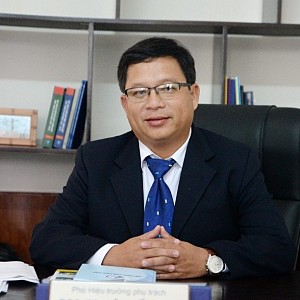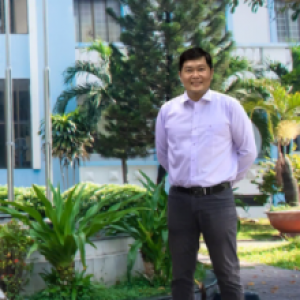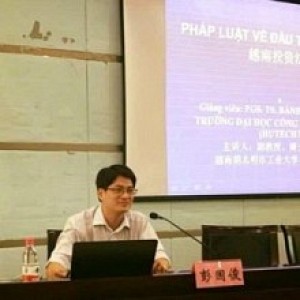Search Papers
19 papers
The administrative merger in Southeast Vietnam has fundamentally reshaped regional governance, spatial configurations, and development priorities, creating urgent requirements for a more integrated approach to science and technology (S&T) human resource development. To assess the implications of this restructuring, the study employs a mixed-methods design that combines institutional diagnostics, comparative policy analysis, and quantitative evaluation of workforce indicators. Empirical data are sourced from national statistical agencies, ministerial datasets, provincial development reports, and international benchmarking studies. The analysis focuses on the S&T workforce within the newly configured administrative units of expanded Ho Chi Minh City, Dong Nai, and Tay Ninh, examining competency structures, spatial distribution, coordination mechanisms, and post-merger system dynamics. The findings reveal significant disparities in qualification profiles, weak cross-provincial linkages in training and research, and limited alignment between workforce planning and emergent regional development trajectories. Despite these constraints, the merger presents opportunities to consolidate training capacity, strengthen innovation networks, and enhance talent mobility. The study argues for a coordinated regional S&T human resource strategy supported by institutional harmonization, a functionally differentiated training system, AI-enabled workforce planning tools, and expanded regional–national–international cooperation to advance a knowledge-based, climate-adaptive development pathway for Southeast Vietnam.
SENIOR UNDERGRADUATE STUDENTS' CHATGPT EXPERIENCE AND PERSPECTIVES DURING ACADEMIC WRITING: A CASE STUDY AT FACULTY OF FOREIGN LANGUAGES, THU DAU MOT UNIVERSITY
Nguyen Hoang Minh Duc
This study examines the use of ChatGPT in students’ report-writing process in the course “Mini-project: British and American work styles”. The participants were 105 senior English majors at Thu Daub Mot University in Vietnam in the second semester of the 2024-2025 school year. This study investigates how students used ChatGPT while writing their reports and their perceptions of its use. A questionnaire containing both closed and open-ended items was administered at the end of the course to collect students’ responses. The results showed that the majority of students used ChatGPT during their writing process. They believed ChatGPT should be integrated into academic writing courses and intended to continue using it in future academic tasks. However, they indicated that more specific university guidelines on the use of AI tools should be provided.
This study aims to provide an overview of the global research landscape related to forensic linguistics. Forensic linguistics is defined as the application of linguistic knowledge within legal contexts, offer unique and powerful tools to assist in resolving issues related to court proceedings. To achieve the research objectives, a thematic literature review method combined with statistical techniques was employed to analyze 34 relevant publications sourced from the Scopus database. The study highlights key aspects such as reputable authors, outstanding works, annual publication trends, and the core content of the published books. The findings provide a global overview of forensic linguistics and reveal four trends: discourse analysis in forensic contexts; corpus-based approaches to legal investigations; language-as-evidence with practical implications for courts; and additional aspects of legal language. Consequently, near-term directions to improve Vietnam’s forensic linguistics scholarship are proposed. The findings not only offer a comprehensive view of the current state of forensic linguistics research worldwide but also facilitate access for scholars in Vietnam to engage with and develop relevant studies in this field. This opens new avenues for research and contributes to enhancing the quality of forensic linguistics scholarship in Vietnam in the future.
Non-English Majors’ Perceptions of Ethical Use and Plagiarism Risks of AI Tools in English Academic Writing: A Study at Thu Dau Mot University
Ho Trung Hau, Le Thi My Duyen, Hoang Doan Gia Han
This study explores non-English major students’ perceptions of the ethical use and plagiarism risks associated with Artificial Intelligence (AI) tools in academic writing at Thu Dau Mot University. As AI technologies become increasingly integrated into higher education, concerns about academic integrity, authorship, and originality have intensified. Using a convergent mixed-methods design, data were collected from 108 students through questionnaires and from six participants via semi-structured interviews. Quantitative findings revealed that a majority of students acknowledged the importance of ethical AI use and expressed support for clearer institutional guidelines and teacher training on responsible AI integration. However, uncertainty persisted regarding the ethical boundaries between legitimate assistance and academic misconduct. Qualitative data reinforced these findings, highlighting students’ awareness of AI’s dual role in enhancing writing skills and posing plagiarism risks, particularly through diminished creativity and loss of personal voice. The study underscores the need for localized policies, updated plagiarism regulations, and pedagogical strategies to guide responsible AI use in EFL writing contexts.
CASE STUDY: APPLYING INFORMATION TECHNOLOGY IN TEACHING FIRST GRADE MATHEMATICS TO DEVELOP COMPREHENSIVE COMPETENCIES FOR PRIMARY SCHOOL STUDENTS
Chu Thi Ngoc Diep, Tran Thi Yen Giang, Pham Quynh Giang
This study evaluated the effectiveness of Information Technology (IT) applications in teaching Grade 1 mathematics to develop students' comprehensive competencies. Tools such as Canva, Twinkl, and online educational games were integrated into lessons to create an engaging learning environment and to enhance students' skills. Significant improvements were observed: students’ ability to sequence numbers increased from 33% to 83.3%, number comparison skills improved from 31% to 90.5%, and effective teamwork skills rose from 40% to 95.2%. Additionally, self-directed learning levels increased from 24% to 85.7%, and creativity in problem-solving grew from 33% to 80.9%. These results underscore the positive impact of IT in developing primary students' academic and collaborative skills.
IMPROVING THE QUALITY OF LAVABO PRODUCTS AT THIEN THANH BATHWARE COMPANY LIMITED
Pham Truong Huyen Mo, Nguyen Vuong Bang Tam
This study focuses on improving the quality of lavabo basin products at Thien Thanh Bathware Company Limited. by applying quality analysis tools such as process flowcharts, check sheets, Pareto charts, and cause-and-effect diagrams. The analysis identified two major defects affecting product quality: impurities and firing cracks. Based on root cause analysis, the study proposes three groups of solutions: (1) cross-training and standardized operation models to enhance workers’ skills; (2) periodic maintenance plans for the vibrating screen to ensure stable equipment performance; and (3) regular mold maintenance to detect early wear or damage. These solutions aim to improve product quality, reduce defect rates, and increase production efficiency.
ARTIFICIAL INTELLIGENCE IN EFL TEACHING: TEACHERS’ READINESS AND ADOPTION INTENTIONS IN THU DAU MOT CITY, BINH DUONG PROVINCE
Tran Thi Le Thu
AI is transforming English as a Foreign Language (EFL) education by facilitating personalized learning and intelligent tutoring globally. This study examines the readiness and intentions of educators in Thu Dau Mot City, Vietnam, to adopt AI in their EFL classrooms. Through surveys and interviews with 102 teachers and lecturers, results show a high perceived usefulness and intention to integrate AI (M = 4.10). However, challenges remain with moderate ease of use (M = 3.92), low confidence in AI tools (M = 3.68), and limited institutional support (M = 3.45). Qualitative insights indicate a need for systematic training and collaborative environments. The findings emphasize that successful AI adoption relies on institutional investment in training and infrastructure. Without this support, the gap between enthusiasm and actual implementation may hinder AI's transformative potential. Policymakers and educational leaders need to create structured frameworks for effective AI integration in EFL classrooms.
AN INVESTIGATION INTO DIFFICULTIES IN READING AND WRITING ENGLISH AS A FOREIGN LANGUAGE
Nguyen Phuong Duy Anh
The study investigates the challenges faced by Food Technology students at Thu Dau Mot University in mastering English reading and writing skills. The findings reveal that limited vocabulary and grammar knowledge significantly hinder students' proficiency in these areas. For reading, students struggle with insufficient vocabulary, poor comprehension strategies, and a lack of background knowledge, making it difficult to understand texts, identify main ideas, and interpret references. Similarly, writing is affected by challenges such as improper grammar usage, insufficient vocabulary, awkward phrasing, and issues with sentence construction. Mistakes in punctuation, spelling, and word order further reduce the quality of written work, limiting students’ ability to express ideas clearly and cohesively. These difficulties stem from a combination of linguistic limitations, lack of exposure to English, and insufficient support in structured learning strategies. The study highlights the urgent need for targeted interventions to address these challenges. Proposed solutions include vocabulary enhancement exercises, grammar-focused sessions, structured reading techniques, and writing workshops. Additionally, integrating modern tools like AI-powered learning applications can provide personalized feedback and improve overall proficiency. By adopting these strategies, students can gradually overcome their difficulties, enhancing their reading and writing skills to meet both academic and professional demands. The findings emphasize the importance of consistent practice and tailored learning approaches in language development.
OVERVIEW OF AI APPLICATIONS IN THE FIELD EDUCATION IN VIETNAM
Ngo Thi Ngoc Diu, Mai Thi Hao, Nguyen Thanh Tung
The application of Artificial Intelligence (AI) in education is rapidly transforming the teaching and learning landscape in Vietnam. AI technology is being integrated into various educational platforms to provide personalized learning experiences, support educators, and enhance the overall efficiency of the education system. In Vietnam, AI is utilized to develop adaptive learning programs, intelligent tutoring systems, and automated administrative processes. AI-powered tools such as virtual teaching assistants and chatbots are also being employed to offer real-time support and feedback to students. Furthermore, AI-driven data analytics is used to monitor and improve student performance and engagement levels. AI assists teachers in automating grading, reducing assessment time, and enabling speech recognition systems to evaluate students’ English-speaking skills. These innovations contribute to a more dynamic, interactive, and inclusive educational environment. However, challenges such as data privacy concerns, the digital divide, and the demand for a skilled workforce remain significant. Addressing these issues is crucial for the sustainable integration of AI into Vietnam’s education sector.
ARTIFICIAL INTELLIGENCE (AI) TOOLS: AN INVESTIGATION ON ENGLISH LANGUAGE UNDERGRADUATE STUDENTS’ ATTITUDE ABOUT THE BENEFITS AND DRAWBACKS
Nguyễn Yến Ngọc, Nguyễn Thị Xuân Hồng
This is a descriptive study to find out students’ awareness about the benefits and harm that they have experienced from using the AI tools during their learning process. The study was founded on a survey and an interview among majored-English students at Thu Dau Mot University. The data was then This descriptive study aims at finding out students’ awareness about the benefits and harm that they have experienced from using AI tools during their learning process. A four-section survey including open and closed-ended questions was sent out, and 193 majored-English students at Thu Dau Mot University responded randomly. The striking finding is that although students preferred AI tools to support their learning, they themselves accepted the benefits gained and the challenges faced were just a little over the average. In particular, the participants confirmed that AI tools contribute much to the fast speed of their academic work completion, but AI also makes them passively think, become inflexible, and somewhat limit the ability to equip knowledge for their English language competence.
DECODING ASIAN FINANCIAL COMPLEXITY: A SYNERGY OF MACHINE LEARNING, CULTURAL HETEROGENEITY, AND ESG INTEGRATION IN ECONOMIC-STATISTICAL FRONTIERS
Tran Vo Hoa Tien, Phan Khanh Duy
Asia’s financial ecosystems, while distinct from Western paradigms, remain underexplored. This study integrates cultural finance, regime-switching machine learning, and ESG asymmetries into a novel analytical framework tailored to Asia’s unique financial architecture. We develop three models: a Hybrid LSTM-GARCH for crisis forecasting, a Bayesian Structural Equation Model capturing informal institutional dynamics, and a machine learning-enhanced Difference-in-Differences model to assess ESG impacts. Theoretically, we propose the Cultural-Statistical Nexus Framework, embedding sociocultural variables into predictive finance, the concept of institutional plasticity to explain regulatory divergence, and ESG Arbitrage Theory to highlight sustainability’s dual role as risk mitigator and speculative signal. Empirically, Confucian Risk Aversion reduces corporate leverage by 15 percent, ESG adoption lowers systemic risk but increases greenwashing, and hybrid models outperform conventional tools in FX crisis prediction. Practical implications include cultural-risk-adjusted capital buffers, AI-based liquidity tools, and region-specific ESG strategies, advancing a globally inclusive paradigm of financial science.
APPLICATION OF THE TWO-STEP FLOW THEORY IN UNIVERSITY ADMISSION COMMUNICATION CAMPAIGNS IN VIETNAM'S DIGITAL ERA
Nguyen Thi Thanh Xuan, Nguyen Dinh Ky
This paper focuses on the application of the two-step flow theory in university admission communication strategies, particularly in the context of university autonomy in Vietnam. The two-step flow theory, developed by Katz and Lazarsfeld (1955), emphasizes the role of opinion leaders in transmitting messages from the information source to the target audience. In addition to analyzing the core elements of the theory and the methods of identifying and utilizing influential individuals within the educational community, this study proposes solutions for applying digital tools to support communication processes. These solutions include optimizing content and search engine tools, organizing both online and offline communication events, and closely coordinating with opinion leaders to implement proactive, flexible, and creative admission communication campaigns that are sustained throughout the process. Consequently, the study aims to enhance the quality of university admissions in the context of digital transformation
GEMINI GOOGLE: A POTENTIAL TOOL FOR ENGLISH LEARNING
Nguyen Phuong Duy Anh
Based on previous surveys, it is evident that Food Technology students at Thu
Dau Mot University face challenges in learning English, such as limited
vocabulary, weak grammar, inaccurate pronunciation, and poor listening and
speaking skills. These can lead to declining academic performance and restricted
career opportunities. The paper highlights the potential of Artificial Intelligence
(AI) in overcoming these challenges. AI tools like Gemini Google can provide
personalized learning experiences, improve interaction with the language, and
offer immediate feedback. Gemini is specifically chosen due to its free access,
Vietnamese interface, and support for over 40 languages. This study
demonstrates that Gemini is an effective tool for undergraduate students,
particularly those in Food Technology who have weak English backgrounds, to
improve their English skills. Gemini improves vocabulary, grammar, speaking,
listening, pronunciation, reading, and writing. It offers simple instructions and
ideas in both English and Vietnamese, making it ideal for beginners, selflearners, and people with limited English proficiency. Unlike traditional
learning, Gemini provides access at any time and from any location, as well as
the ability to overcome shyness and blunders. Gemini's large, up-to-date
database and user-friendly interface enable personalized learning paths and can
be paired with other methods for best language learning. The study also proposes
various strategies for utilizing Gemini Google to improve English learning
effectiveness in areas like vocabulary, grammar, listening, speaking, reading,
writing, and creating a positive learning environment. Furthermore, Gemini's
value extends beyond languages, offering assistance in a variety of other areas.
THE TOOL FOR WRAPPING BAGS AND PICKING FRUITS
Ngo Bao, Tran Thi Vinh
The act of picking fruit is very familiar and associated with the history of hunting, catching, gathering, and gathering of humans, so they have come up with many types of tools for this job. The practice of wrapping fruit in bags before harvest has only been applied recently, so it is still very new and rudimentary. These tools only perform each function individually. Therefore, the author has inherited and proposed a tool that has two functions at the same time: wrapping bags and picking fruit at high altitude. This article presents the structure, operating principles, and instructions for using this tool. This tool is compact, inexpensive, and easy to use. It consists of a long handle, a set of clamps that close and open, and a control cable connecting from the top to the middle of the handle. Farmers just need to stand on the ground, put the clamps over the fruit, and pull the control cable to make the clamps close or open. From there, they can wrap bag or pick fruits from high above easily. This research will help farmers have a tool that has two functions, which certainly has many advantages and is useful for farmers.
Keywords: cloth bags, cover fruit bags, fruit pickers, plastic bags, tools.
APPLICATION OF LEAN MANUFACTURING TO REDUCE WASTE AT PROTRADE GARMENT JOINT STOCK COMPANY
Nguyen Vuong Bang Tam
The Covid pandemic and economic recession have seriously affected the business and production activities of businesses. This article proposes the application of Lean manufacturing to identify waste and propose solutions to reduce waste at Protrade Garment Joint Stock Company. In this study, tools in Lean and JIT were used to identify waste in the production process and calculate the cost of losses caused by waste. Research results have reduced waste due to transportation and help Protrade Garment Joint Stock Company increase its competitiveness in the market.
Keywords:Lean, waste, cost , 5S.
MONITORING THE END-EFFECT POSITION OF THE THREE-JOINT ROTARY MANIPULATOR IN MATLAB SIMMECHANICS USING THE PID ALGORITHM
Tan Nguyen Van, Xuan Vinh Ha
Industrial robots have become one of the effective support tools for human labor. Robots are a solution to replace humans in repetitive tasks and in environments where humans cannot work. Robots have become one of the factors responding to the Industrial Revolution 4.0. Automatic control devices require high-precision control quality. Therefore, in this paper, we focus on researching controlling the position of the actuator accurately based on the PID algorithm. First, we study the forward and inverse kinematics of a three-joint robot. Second, we design the robot model on inventor software and transfer the 3d model in inventor software to Matlab Simmechanics. Third, modeling robot model on Simulink to simulate and evaluate the results achieved
On the Robin-Dirchlet problem for a nonlinear wave equation with the term 1 n Xn i=1 u2(i−1 n , t)
Nguyen Vu Dzung, Tran Trinh Manh Dung
In this paper, we study the Robin-Dirchlet problem (Pn) for a wave equation with the
term
1
n
Xn
i=1
u2( i−1
n , t), n ∈ N. First, for each n ∈ N, under suitable conditions, we prove
the local existence and uniqueness of the weak solution un of (Pn). Next, we prove that
the sequence of solutions un of (Pn) converges strongly in appropriate spaces to the weak
solution u of the problem (P), where (P) is defined by (Pn) by replacing
1
n
Xn
i=1
u2( i−1
n , t)
by
Z 1
0
u2(y, t)dy. The main tools used here are the linearization method together with
the Faedo-Galerkin method and the weak compact method. We end the paper with a
remark related to a similar problem.
Target prediction and functional annotation analysis for potential microRNAs associated with Glioma
Nguyen Bang Phi, Vo Hoang Xuan Dat
Glioma is a deadly tumor that accounts for the majority of malignancies of the brain and central nervous system. Currently, applying biomarkers and combining with clinical treatments in the diagnosis and prognosis of Glioma is the optimal trend. Among the effective biomarkers, microRNA has emerged as a novel, efficient biomarker. In this study, we used data from the Kyoto Encyclopedia of Genome and Gene Routes Database (KEGG) and bioinformatics tools for functional prediction and annotation of two Glioma-associated molecules (miR-6780a-5p and miR-6754-3p). The result indicated that 361 genes relating with two molecules miR-6780a-5p and miR-6754-3p. In which, miR-6780a-5p interacts with 198 genes and miR-6754-3p interacts with 166 genes. PPI analysis (protein-protein interaction analysis) and functional enrichment analysis revealed that target molecules of two miRNAs (miR-6780a-5p, miR-6754-3p) belong to cancer signaling pathways such as MAPK (Mitogen-activated protein kinase) and WNT (Wingless-related integration site). In addition, two miRNAs (miR-6780a-5p and miR-6754-3p) affect not only Glioma but also regulation in many other cancers such as pancreatic, thyroid, and endometrial cancer. Briefly, the result has clarified the role of (miR-6780a-5p, miR-6754-3p) in regulating signaling pathway of Glioma, thereby evaluating the interaction between miRNAs, target genes and target signaling pathways, and also supporting for the selection of potential biomarkers in Glioma diagnosis
Suggestions for training strategy of Thu Dau Mot University in the process of approaching industrial revolution 4.0
Trinh Phuong Thao
Industrial Revolution 4.0 has become an indispensable trend in the development process of Vietnam and is increasingly applied in university education. The essence of the Industrial Revolution 4.0 is the application of technology, data science and the use of artificial intelligence for production and human life. In this impact, modern education, especially higher education, is the field most affected. Online teaching, with tools to support the teaching of the digital age, has been changing dramatically in the teaching and learning situation in universities, helping to modernize education and integrate with the world, but there are many issues that teachers and managers must consider to change teaching methods and training strategies, in order to deliver the best results. Starting from the actual situation, we propose specific and comprehensive measures to improve the teaching efficiency of Thu Dau Mot University and, to meet the needs of Vietnamese society and the development of Industrial Revolution 4.0.
Publication Information
Publisher
Thu Dau Mot University, Viet Nam
Editor-in-Chief

Assoc. Prof. Nguyen Van Hiep
Thu Dau Mot University
Thu Dau Mot University
Editorial Board

Assoc. Prof. Le Tuan Anh
Thu Dau Mot University
Thu Dau Mot University

PhD. Nguyen Quoc Cuong
Thu Dau Mot University
Thu Dau Mot University

PhD. Doan Ngoc Xuan
Thu Dau Mot University
Thu Dau Mot University

PhD. Nguyen Khoa Truong An
Thu Dau Mot University
Thu Dau Mot University

Assoc. Prof. Nguyen Thanh Binh
Thu Dau Mot University
Thu Dau Mot University

PhD. Le Thi Thuy Dung
Thu Dau Mot University
Thu Dau Mot University

PhD. Ngo Hong Diep
Thu Dau Mot University
Thu Dau Mot University

PhD. Nguyen Duc Dat Duc
Ho Chi Minh City University of Industry and Trade
Ho Chi Minh City University of Industry and Trade

Assoc. Prof. Nguyen Van Duc
Animal Husbandry Association of Vietnam
Animal Husbandry Association of Vietnam

PhD. Nguyen Thi Nhat Hang
Department of Education and Training of Binh Duong Province
Department of Education and Training of Binh Duong Province

PhD. Nguyen Thi Cam Le
Vietnam Aviation Academy
Vietnam Aviation Academy

PhD. Trần Hạnh Minh Phương
Thu Dau Mot University
Thu Dau Mot University

M.A. Pham Van Thinh
Thu Dau Mot University
Thu Dau Mot University

PhD. Nguyen Thi Lien Thuong
Thu Dau Mot University
Thu Dau Mot University

Prof. Le Quang Tri
Can Tho University
Can Tho University

Prof. Banh Quoc Tuan
Thu Dau Mot University
Thu Dau Mot University

